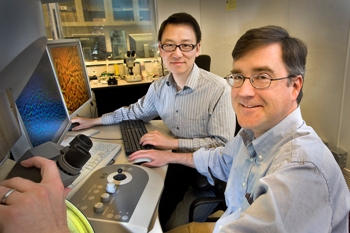Scientists at the Brookhaven National Laboratory have discovered the nanostructure of a new carbon form that could explain its behavior as a high-absorbent sponge when it receives electric charge.
The material recently developed at The University of Texas, Austin, could be integrated into “supercapacitor” devices for high capacity energy storage while maintaining other properties including quick recharge time, rapid release of energy, and long lifetime cycles of 10,000 charge/discharge cycles.
 Dong Su and Eric Stach use a powerful electron microscope to analyze samples of activated graphene at Brookhaven’s Center for Functional Nanomaterials. Says Stach: “The CFN provides access to scientists around the world to solve cutting-edge problems in nanoscience and nanotechnology. This work is exactly what this facility was established to do.”
Dong Su and Eric Stach use a powerful electron microscope to analyze samples of activated graphene at Brookhaven’s Center for Functional Nanomaterials. Says Stach: “The CFN provides access to scientists around the world to solve cutting-edge problems in nanoscience and nanotechnology. This work is exactly what this facility was established to do.”
According to Eric Stach, Brookhaven materials scientist, this makes it suited to store electrical energy needing rapid energy release in electric cars or to regularize power derived from alternate sources like wind and solar power. Stach has also co-authored the research paper released recently in Science.
The Supercapacitors resemble batteries due to their capability to store energy. Batteries store a lot of energy through chemical reactions and release it over long periods. But supercapacitors store charge in ion form on the electrodes’ surface like static electricity without depending on chemical reactions. Charging the electrodes make the ions separate or polarize allowing the charge to get stored at the junction of the electrodes and electrolyte. Electrode pores enhance the surface area where the electrolyte can travel and communicate. This enhances the quantity of energy being stored. The limited charge in the capacitors allows them to be applied in mobile electronic systems, which need limited energy and can operate over long periods.
The team used potassium hydroxide to remodel chemically adapted graphene platelets by creating a more porous form of carbon that needed to be characterized at the nanoscale. Investigations revealed that the material's three-dimensional nanostructure comprised a network of curved, nano-thick walls that formed nano pores measuring 1 to 5nm wide.
Stach said that along with computational studies they are trying to comprehend the formation of this three-dimensional network to customize the pore sizes to be most advantageous for particular applications including capacitive storage, catalysis, and fuel cells.
The team carried out its research at the Lab's Center for Functional Nanomaterials, the National Synchrotron Light Source and the National Center for Electron Microscopy at Lawrence Berkeley National Laboratory. The facilities are supported by the DOE Office of Science.
The research program was funded by DOE's Office of Science. The work at UT - Austin was funded by the Office of Science, the National Science Foundation, and the Advanced Technology Institute.